Sail on a rowing boat «Chizhik» — manufacture of sailing weapons
For the project for the independent construction of the Chizhik boat, see on this page.
| Basic data of the boat «Chizhik» | |
|---|---|
| Longest length, m | 3,47 |
| Maximum width, m | 1,47 |
| Side height, m | 0,50 |
| Load capacity, kg | about 300 |
| Power PM, hp | up to 5 |
General view of the boat with a sail and details of attaching the sail to the mast
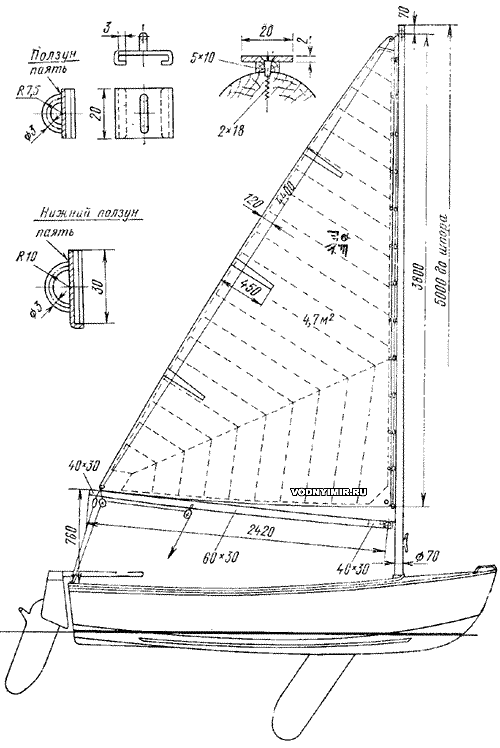
Theoretical drawing of the «Chizhik» hull

Table of plaz ordinates
| Line | frame no. | ||||
| 1 | 2 | 3 | 4 | Tr. | |
| Half-width from DP, mm: | |||||
| Skula — LSk | 345 | 594 | 637 | 585 | 493 |
| Board — LB | 541 | 718 | 733 | 671 | 563 |
| Heights from OL, mm: | |||||
| Keel | 35 | 3 | 7 | 68 | 140 |
| Skula — LSK | 197 | 114 | 117 | 166 | 223 |
| Board — LB | 590 | 520 | 488 | 497 | 522 |
A mast with a sail mounted on an ordinary rowing boat does not yet turn it into a real sailboat. In addition to the sail and the mast with rigging, allowing you to set the sail and control it, you need a rudder with an increased pen area and, of course, a shvert or shverts that keep the boat from excessive lateral drift (drift) at lateral and, especially, steep to the wind courses — at an angle of up to 40-50° towards the wind.
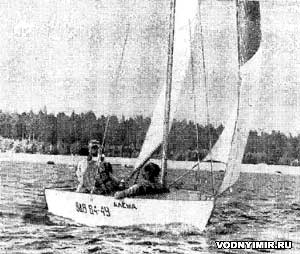 «Alyosha» is the first shverbot based on «Chizhik», built in Gus-Khrustalny by V. Zhirnov. The case is made exactly according to the drawings given in No. 24 «Boats and yachts». A rigid jar is placed across the body, loosening the mooring well. The aft fin is made higher — up to 120 mm on the transom. The shvertbot is armed with a sloop — with a sail area of about 6 m². The full height of the mast, loosened by a staff (st. cable Ø 3) and shrouds with screw lanyards, is 5.8 m from the steps. The mast and boom (2.0 m) are glued together from pine slats and have a likpaz. The cable shoulder straps of the boom-sheet are hung on the transom. A block of Ø 25 mm slides along the shoulder strap; the boom-sheet is carried through a block approximately in the middle of the boom and a footblock fixed to the bottom. Unsinkability is provided by foam blocks under the payoles. |
The placement of the crew, and, consequently, the arrangement of cans, on a sailing boat is always not the same as on a rowing or motor boat: the crew must tilt the boat, counteracting the heeling pressure of the wind, and for this people need to be placed along the side. In addition, the dimensions and shape of the hull of the boat must meet the conditions of sailing, i.e. be designed to move at a relatively low speed. «Chizhik» (see here) was designed as a rowing boat with the possibility of using a low-power outboard motor: naturally, the design of the boat was designed specifically for these use cases. So, a longitudinal middle bank for a rower was arranged on the «Chizhik»; thanks to this, it is possible to give the boat an optimal trim depending on the number of passengers, there is free space for passage along the boat, on the sides of this bank you can sleep on slates. However, the same jar is not needed at all on the «Chizhik»-centerboarder.
To transform the «Chizhik» into a sailing boat, appropriate changes in the design of its hull are necessary, therefore, readers of the collection interested in this issue are offered two options:
Option 1 — most fully takes into account the requirements for a sailing and rowing boat, but provides for significant changes in the original design. This option is better implemented by those who are just going to build a «Chizhik».
Option 2 is a compromise solution that provides for a minimum of changes to the finished boat built according to the original drawings.
In option 1, the equipment of the mooring well, the transverse and two side cans in the cockpit and the fastening of removable parts — the mast and rudder are required. The hull of the boat is built according to the original design, but the on-board stringer is brought to shp. 1. Instead of a longitudinal can, a mooring well is installed, which is a narrow box, open only from below, fixed with screws on glue above the slot for the mooring in the keel. The well is loosened by a transverse jar resting on the side stringer. The walls of the well and the flooring of the jar are cut out of water-resistant plywood with a thickness of 6 mm. The final assembly of the well is carried out after fixing the vertical racks on the shp. 2 from the inside. On the «Chizhik» it is convenient to have a well closed from above — through an open well (it would have to be made low) with any significant excitement, water would splash into the boat.
«Chizhik's» equipment with a shvert and steering device
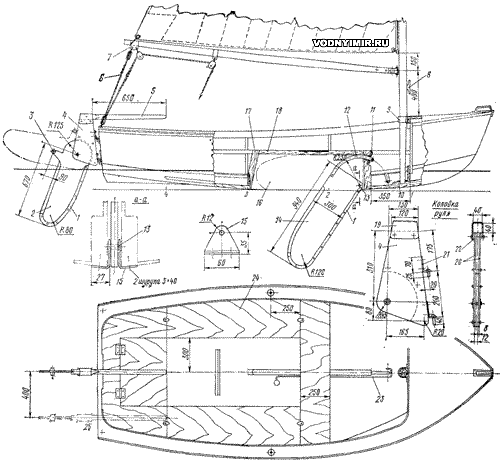
zoom in, 98.6 KB
1 — shackle made of 1x30 strip; 2 — rudder pen, backfanner δ=12; 3 — handle for lifting the pen; 4 — rudder pad; 5 — tiller, 40x40; 6 — boom-sheet; 7 — boom clip, δ=2 mm; 8 — weft for the halyard; 9 — clip of the nz strip 3x40, fastened to the beam with through bolts M6; 10 — step pad, δ=2 mm with a rectangular hole for the mast spur; 11 — sealing the hole for the rod 12; 12 — rod from the tube Ø 20 mm; 13 — shaft axis — finger Ø 12 mm; 14 — shaft, backfanner δ=12; 15 — cheeks of the shaft axis, δ=2.5 mm; 16 — well wall; plywood δ=6; 17 — the rack (key) of the well 25x60; 18 — the gunwale-the plug of the well 25x30; 19 — the tiller clip, δ=2; 20 — side cheeks pads, backfans δ=8; 21 — steering loop; 22 — plywood gasket δ=6; 23 — the draft of the shvert; 24 — side seats-banks; 25 — the position of the rudder when rowing.
In connection with the tourist purpose of the boat, it is necessary to use a rotary shvert; simpler non—rotating — «sticking» shverts cause hard impacts when colliding with underwater obstacles and are inconvenient, and sometimes even dangerous when swimming in an unfamiliar area.
The screw rotates on an axis, the cheeks of which are fastened with screws outside the keel to avoid drilling holes in the lower part of the screw well. The screw is rotated by means of a rod made of a metal rod or a thick-walled tube with a diameter of 20 mm, riveted to its trailing edge (do not forget to put a plug in the tube!). The rod must be very carefully bent around a circle with a radius of 250 mm (along the axis). At its exit from the shaft well, a seal made of microporous rubber with a thickness of about 10 mm, pressed with a metal pad, is installed. The hole in the rubber should be of a smaller diameter than the rod. The screw is raised and lowered by a pusher made of a 4x30 metal strip pivotally attached to the rod by an M8 screw. At the aft end of the pusher, it is desirable to install a handle in the form of a wooden ball (the idea of this design is borrowed from an old boat).
Cross-section along the mooring well
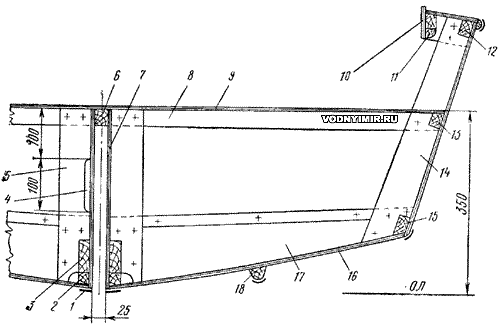
1 — shackle 20x2; 2 — keel 25x80; 3 — base of the well 20x60; 4 — cutout for the shvert pusher; 5 — well post 20x60; 6 — well gunwale 25x30; 7 — well wall, δ=6; 8 — transverse stiffness rib banks 20x30; 9 — bank flooring, δ=6; 10 — coamings, plywood 4x50; 11 — carlengs, 20x25; 12 — anchor beam, 18x30; 13 — support bar of the jar, 18x30; 14 — toptimbers δ=20; 15 — zygomatic stringer, 18x30; 16 — skin, δ=4; 17 — flortimbers δ=20; 18 — bottom skid 20x30.
The front and rear edges of the screw should be sharpened, and it is desirable to fix a protective shackle made of a brass strip with a thickness of 1 mm along the front edge.
It is most convenient to use removable side cans based on a side stringer, a thrust bar on the bulkhead of the aft locker and a strip of plywood under the transverse can. They are held in place by rotary retainers, the same as the retainers of the poles. Under the longitudinal banks, it is necessary to securely attach foam buoyancy blocks to the hull of the boat.
The steering wheel consists of a steering pad and a lifting pen. The block is assembled on glue and bolts with a diameter of 5-6 mm from three layers of bakelized plywood. The middle part with a thickness of 12 mm has a sector cutout for the steering wheel pen. The side cheeks are 8 mm thick. The tiller is attached to the pad with a metal clip bent from a sheet. Steering loops are cut out of a square with a wall thickness of at least 4 mm or bent out of the strip and attached to the pad with screws with a diameter of 6 mm. The pins (made of M8 bolts with cut heads) are screwed into the thread of the loop holes and riveted. The lower pin must necessarily be about 20 mm longer than the upper one, otherwise the steering wheel will be difficult to install in place. The details of the steering loops attached to the transom are also cut out of the square and mounted on through bolts M6.
The steering wheel feather is cut from bakelized plywood with a thickness of 12 mm and, just like the screw, is sharpened along the edges and protected by a shackle. The axis of the pen is the M8 bolt, the tightening of which is adjusted so that the raised pen is held by friction against the cheeks of the pad. The upper part of the steering wheel pen should be sanded so that it freely enters the slot of the shoe. The pen is lowered into the water directly by hand; for this, a lever with a handle is provided on its trailing edge. To insure against jumping out of the loops, the steering wheel is fixed with a flat spring fixed above the lower steering loop.
On the transom of the boat on the starboard side at a distance of 400 mm from the DP, a second pair of steering loops is installed, on which the steering wheel is outweighed during the course of the oars. This is very convenient for the helmsman, since the tiller moves freely under the right hand, and does not rest on the back; the displacement of the steering wheel practically does not affect the controllability of the boat.
The mast billet is glued out of three or four pine bars of the desired length. The cross section of the mast is higher than the cockpit coaming and up to about half the height is a circle with a diameter of 70 mm. Above this level, the front and side edges are smoothly rounded to the section on the top 40x50, at the bottom — to the section at the spur 30x50 (larger in both cases along the DP).
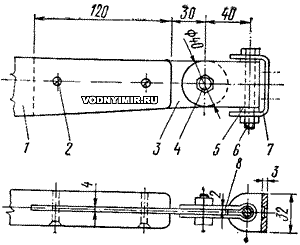 The simplest swivel boom: The simplest swivel boom:1 — boom; 2 — screw M5 2 pcs.; 3 — strip δ=3 to cut into the boom; 4, 6 — bolts M8; 5 — washer 8; 7 — bracket, attach to the mast with two screws 5x32; 8 — clip, δ=2. |
A pulley for the halyard is cut into the upper part of the mast; the boom swivel and the halyard weft are attached at the bottom. Along the trailing edge of the mast, the rail for the mainsail sliders is fixed with screws through a 5x10 rail — a carefully aligned 2x20 metal strip.
The mast spur enters the 25 mm deep step socket, cut out in the rear part of the stem, and reinforced with a 2 mm thick metal bracket superimposed on top with a rectangular hole cut in it for the passage of the spur.
The finished mast, like all the details of the mast, is covered with a colorless varnish (oil or pentaphthalic). There is no standing rigging — shrouds and shrouds are not needed; the mast, along with the boom and sail, is easy to remove from the boat. If necessary, you can make the mast collapsible. In this case, the upper and lower parts of the mast are connected by a coupling made of metal pipe with a wall thickness of about 2 mm. The 400 mm long coupling is attached with screws or through bolts to the top of the mast; to fix the correct position of the connected parts of the mast, a screw with a diameter of M6 is screwed into the lower part, and a slot with a depth of about 20 mm is made in the coupling. In the area of the coupling, the rail for the mainsail sliders is mounted on short M4 screws screwed into the threaded holes.
It is better to glue a boom with a section of 30x60 in thickness from two pine bars. At the ends, the boom is rounded along the lower edge to a height of 40 mm.
With hardware sailing armament according to the second variant, the boat is no longer equipped with a mooring line, but with hinged mooring lines. On both sides in the area of the shp. 2 a support bar for a transverse jar is installed on the inside of the skin (cut on the frame), and a bar for the stop of the seams is installed on the outside. The transverse bank is attached to these support bars at the side and to the longitudinal bank. Under the deck, on both sides of the beam shp. 2, pillows for the bearings of the shverts are installed.
Boat version with shverts
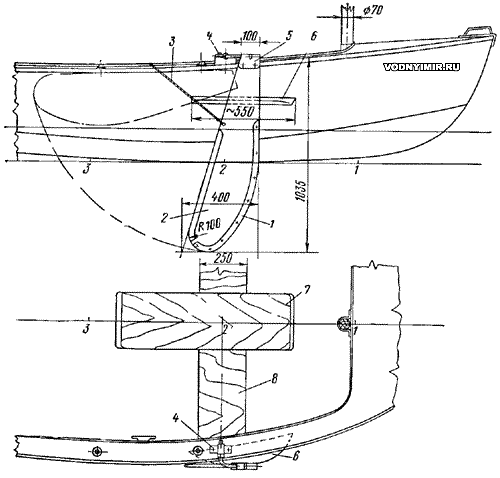
1 — shvortsa, 1x40, brass; 2 — shvortsa, backfanner δ=15-16; 3 — sorlin; 4 — bearing; 5 — steel cage Ø=3; 6 — support bar; 7 — longitudinal seat; 8 — transverse jar δ=6; 9 — pine lining; 10 — check; 11 — bent axis; 12 — locking ring.
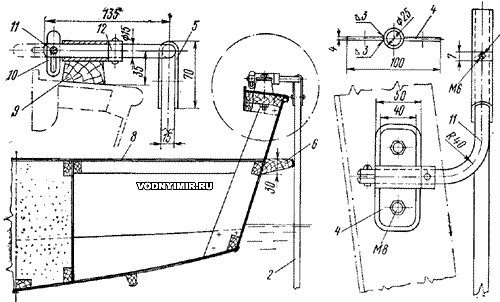
The seams are cut out of bakelized plywood with a thickness of 15-16 mm, their vertical edges are sharpened, protective shackles are placed on them. The upper part of the shaft is put on the axis of a steel bar with a diameter of 16 mm, bent at right angles. In the schwartz cage, the axis is fixed with a stopper in the form of an M6 screw without a head, screwed into the axis and walking in the slots of the cage. The shaft axis is inserted into the deck bearing and fixed in it with a rotary check. The transverse movements of the axis in the bearing are limited to a piece of the tube riveted to it, from which the sleeve of the cage was made. The shverts are raised by sorlins, which are laid on the ducks inside the boat.
The design of the mast, boom and rudder is the same as in the 1st variant, but it is recommended to reduce the sail area by 1 m, taking into account that the area of the shverts is smaller than the shvert, and the possibilities for opening the boat due to a different arrangement of cans are somewhat worse.
The manufacture of sailing weapons is a rather complicated and time-consuming task, but the pleasure of sailing, no doubt, will more than pay for this work. However, it is necessary to warn that the management of a sailing boat, even such a small one as the «Chizhik», requires special training of the helmsman. It is best to learn sailing in a yacht club.
When studying the art of sailing on your own, you should strictly observe the basic safety rules:
— do not overload the boat; do not take on board people who cannot swim and small children;
— when sailing, the crew must always wear life jackets;
— watch the weather carefully; if there is a danger of a squall, immediately remove the sail and sit down at the oars;
— it is impossible to sail with a wind stronger than 4 points, and in the beginning, with insufficient experience, more than 3 points;
— never lay the sheets on the duck; always keep the halyard cove clean — ready for lowering the sail;
— when going out under sail, check if you forgot to take the oars;
— until you have gained confidence in your abilities, do not leave the area where you can be given immediate help in case of a rollover.
Boat projects for self-construction
Share this page in the social. networks or bookmark:
